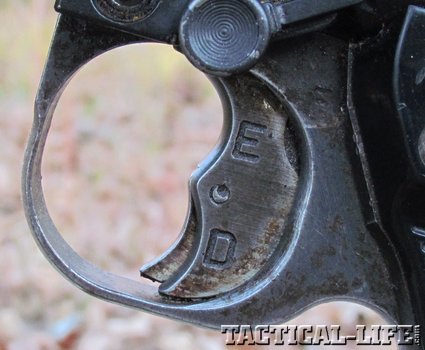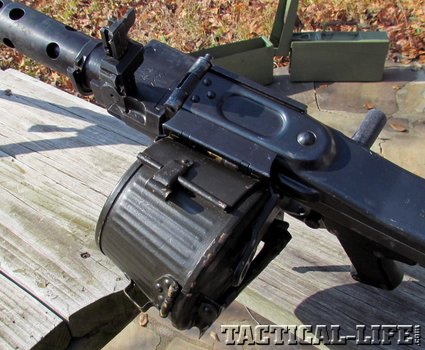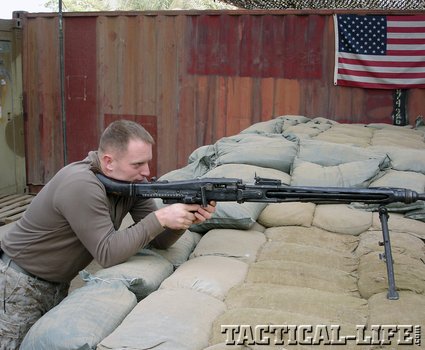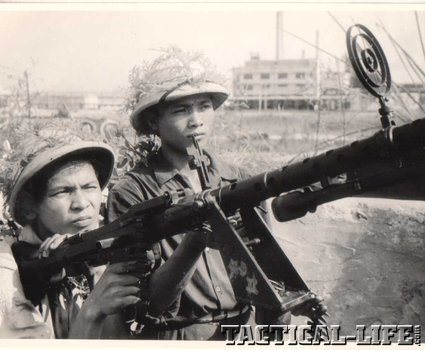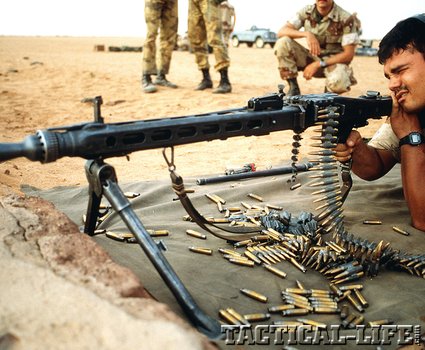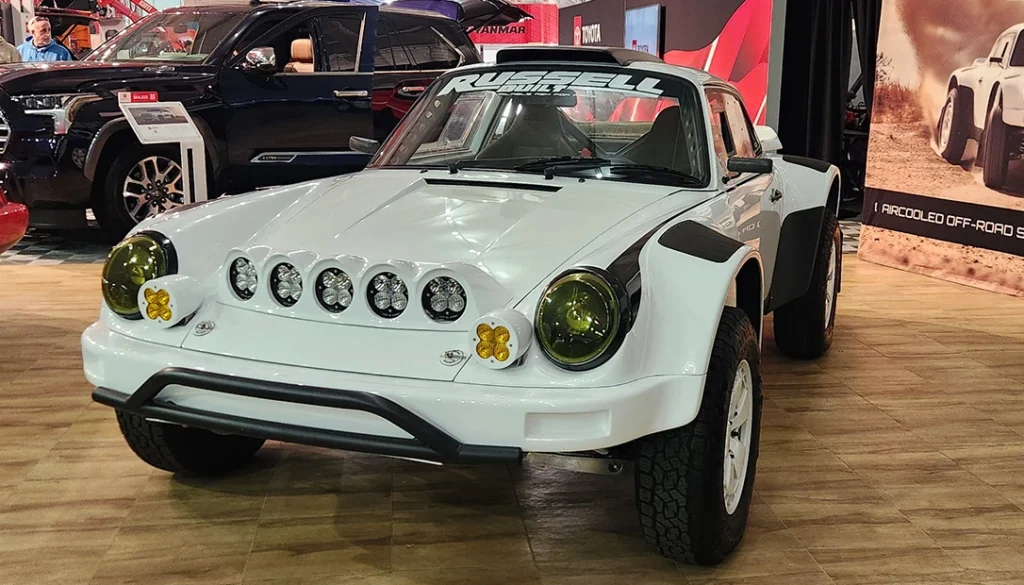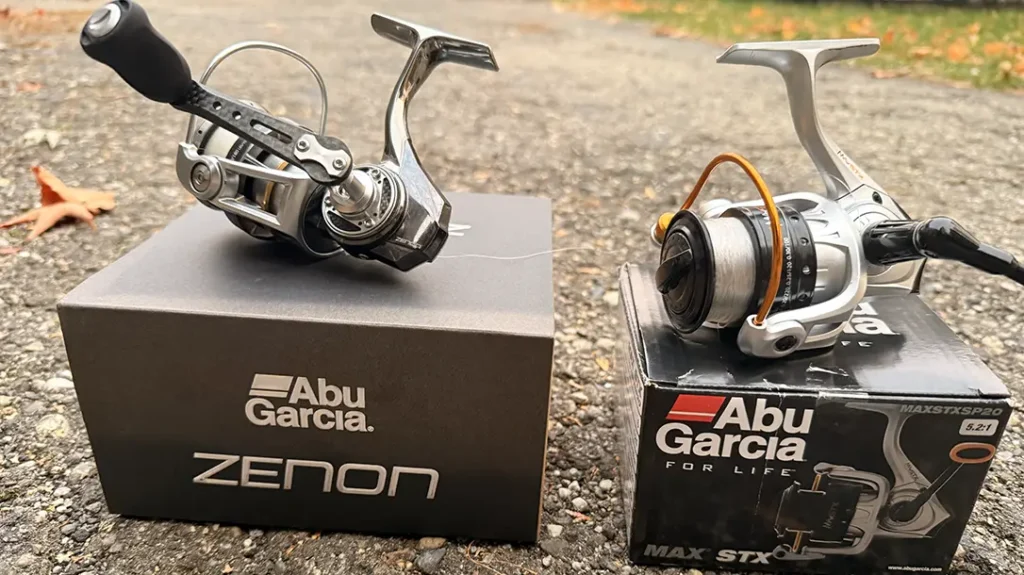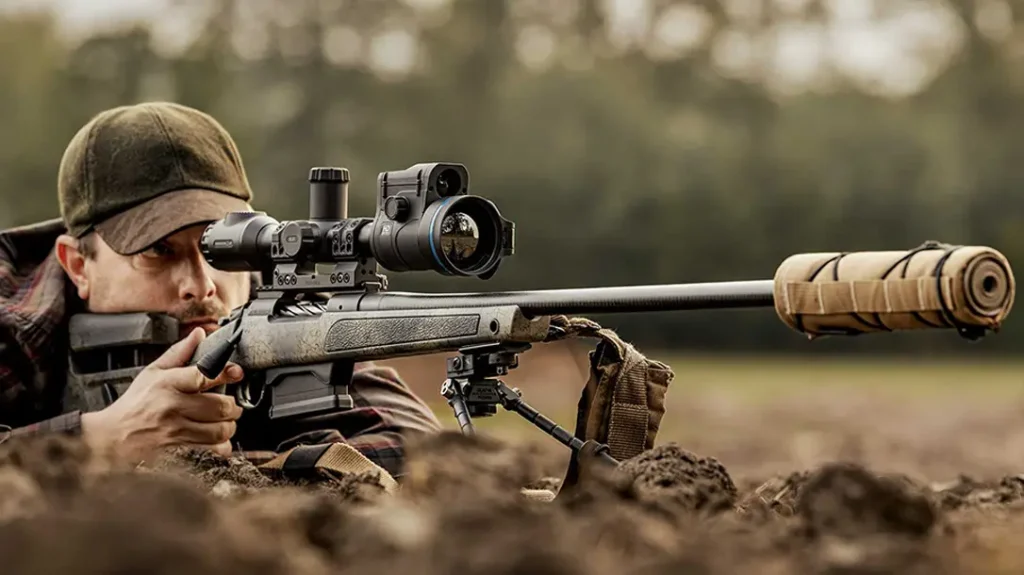These days, belt-fed general-purpose machine guns (GPMG) are ubiquitous in the arsenals of all modern armies. The Belgian-designed M-240 that equips U.S. forces was born in the immediate aftermath of World War II as the Mitrailleuse D’Appui General (MAG) gun. The MAG gun was designed by Ernest Vervier and mated the modified action of the Browning Automatic Rifle to the belt-feed system of the German MG-42. In American use, the weapon serves as a man-portable crew-served infantry support weapon, a coaxial tank machinegun, a helicopter door gun, a remote-fired turret-mounted weapon and a tripod-mounted defensive weapon for fixed installations. The same action and receiver may be alternately fitted with various mounts, tripods, grips, stocks, and solenoids to serve in all of these roles yet retain maximum parts commonality. Variants of this basic weapon are used by dozens of nations.
The World War II-era German MG-42 went through a variety of design evolutions to become the contemporary MG-3 and its cousins the M-53 and MG-42/59. This system of guns has been successfully chambered in 7.92x57mm, 7.62x51mm and even 5.56×45 mm. The MG-3 and its relatives have been used in a variety of anti-aircraft, vehicle and ground mounting systems. The MG-3 is currently in use by 17 different coalition militaries in the ongoing global war on terror. The MG-3 is still in production in several countries more than 70 years after its introduction.
The Combloc Pulemet Kalashnikova (PK) series machineguns were designed under the supervision of Mikhail Timofeyovich Kalashnikov and employ an ingenious inverted adaptation of the basic Kalashnikov rifle action. The PKS (Stankovy) fires from an integral bipod. The PKT version is adapted for use in armored vehicles. The PK series of guns has been distributed via the same legal and illicit arms-distribution systems that have supplied the world’s dictators, warlords, totalitarian ideologues and malevolent militarized children with more than 100 million Kalashnikov assault rifles. As with the MAG and MG-3, the basic PK chassis has been adapted to countless tactical configurations.
Advertisement — Continue Reading Below
The U.S. M-60—an adaptation of the WW II German FG-42 Fallschirmjager Gewehr paratrooper rifle—and the German HK-21, a belt-fed variant of the G-3 Battle Rifle, also fall into the same broad category. In each case, the contemporary weapon can trace its genesis back to the WW II-era German MG-34.
First Battle Rattlers
Formally accepted on January 24, 1939, the MG-34 represented a revolutionary step forward in machine gun design. Belt-fed machine guns had earned a pre-eminent position in the arsenals of militarized nations in World War I. On the blood-soaked battlefields of France, crew-served, water-cooled behemoths spewed death on a scale previously unimagined. While most combatants inculcated the lessons of static trench warfare into their official doctrine and armed themselves accordingly, the Germans embraced tactics based on mobility. In this vein, the Nazis developed the world’s first practical general-purpose machine gun, the MG-34.
Advertisement — Continue Reading Below
Unlike its water-cooled WW I predecessor, the MG-08, the MG-34 was air-cooled and was, at 26.5 pounds unloaded, highly portable. By contrast, the MG-08 with its sled mount weighed 123 pounds. The MG-34 was designed under the supervision of Ritter von Webber and Louis Stange and was recoil operated. The design incorporated a muzzle booster to ensure that sufficient recoil energy was harnessed to operate the action, as well as a plethora of other modern features.
The MG-34
Much has been made of the complexity of the MG-34 and its status as an exemplar of the gunmaker’s art. This is not hollow praise. The receiver and bolt assemblies sport countless cuts and facets that must have been incredibly difficult to produce under wartime conditions with 1930s-era machine tools. Cycling the action, even on an old gun, is akin to operating a sewing machine. The parts just glide across each other. While this is impressive under controlled conditions on a modern range, it was likely fairly frustrating when fouled with frozen Russian mud.
Advertisement — Continue Reading Below
The gun carried a folding bipod (Zweibein), and the firing mechanism was user selectable with a selector built into the trigger. Pressure on the top portion of the trigger produced semi-automatic fire while pressure on the bottom of the trigger fired the gun automatically. Ammunition could be fed via non-disintegrating belts (Patronengurt) from 50-round basket drums or large ammunition boxes. Additionally, the top cover could be removed and replaced with a complicated 75-round double drum magazine (Patronentrommel) that was spring driven in the manner of a contemporary Beta mag. A large detachable ring anti-aircraft sight was issued, and the standard iron sights folded out of the way for transport.
Accessories for the MG-34 system were legion. With the buttstock removed and an armored barrel jacket emplaced, the gun served as an auxiliary tank weapon. Mounted on a tripod (Lafette), the gun operated remotely such that it could fire over a parapet through a periscope sight attached to the mount. A single pedestal mount (Fliegerdrehstutze) or dual mount (Zwillingssockel) allowed the gun to be employed in an anti-aircraft role. A winter trigger attachment along with a variety of arctic-specific accessories were devised to keep the gun running in the frozen Russian winter.
Behind The Beast
Advertisement — Continue Reading Below
Allied and Axis attitudes toward machine gun design were fundamentally disparate. Allied theory held that a machine gun should chug along at a sedate pace so as to facilitate prolonged searching fire and minimize ammunition expenditure. As such, the standard U.S. 1919A4 and 1919A6 guns ran at around 400-550 rounds per minute (rpm). Modern guns such as the M-60, PK and MAG/M-240 family follow a similar model, though the M-240 does has an adjustable gas regulator that will facilitate rates of fire of up to 1,000 rpm.
In contrast, German planners envisioned fleeting targets that provided short engagement windows. Their weapons were designed to fire rapidly so as to provide a high volume of fire in dense bursts to saturate a target. As such, the MG-34 runs at a cyclic rate of around 900 rpm, while the later MG-42 burned through ammo at 1,200 rpm. This is, incidentally, the same rate of fire as the MAC-10 submachine gun, a notorious little bullet hose.
The 7.92x57mm cartridge is a full-sized military cartridge in the same league as the U.S. .30-06 and British .303 rounds. As such, while the mass of the gun tames the recoil to a great degree, its rate of fire makes the MG-34 fearsome downrange. Like most belt-fed guns not designed by John Moses Browning, the MG-34 fires from the open bolt position.
Advertisement — Continue Reading Below
With most things, be it a small arm or brain surgery, success is driven by training and repetition. So long as the operator lets his weight absorb the recoil and keeps bursts to a manageable length, the MG-34 is a devastating weapon system every bit as effective as its contemporary counterparts. Five- to 10-round bursts seem natural, and beaten zones are readily managed with appropriate technique.
The true strength of the MG-34 was its mobility. While the gun is much too heavy to be fired offhand from the shoulder, burst fire from the hip using the sling is remarkably intuitive. Whether it be suppressive fire in moderate bursts from a supported position or walking fire on an assault, the MG-34 is comparably effective to the M-60’s and M-240’s that I myself have used operationally.
Stuff Of Legend
Advertisement — Continue Reading Below
The MG-34 is a magnificently engineered and beautifully executed piece of machinery. Hundreds of thousands of MG-34’s were manufactured during WW II, and many were subsequently distributed or smuggled across the globe. Israel utilized great numbers of them during their war for independence and the gun was commonly encountered by U.S. forces in Vietnam. Given many a low-rent dictator’s propensity for hoarding, the MG-34 still shows up today from time to time, though the lack of reliable 7.92x57mm ammunition limits its utility. The MG-34 will always retain its place in history as the first of its kind.
